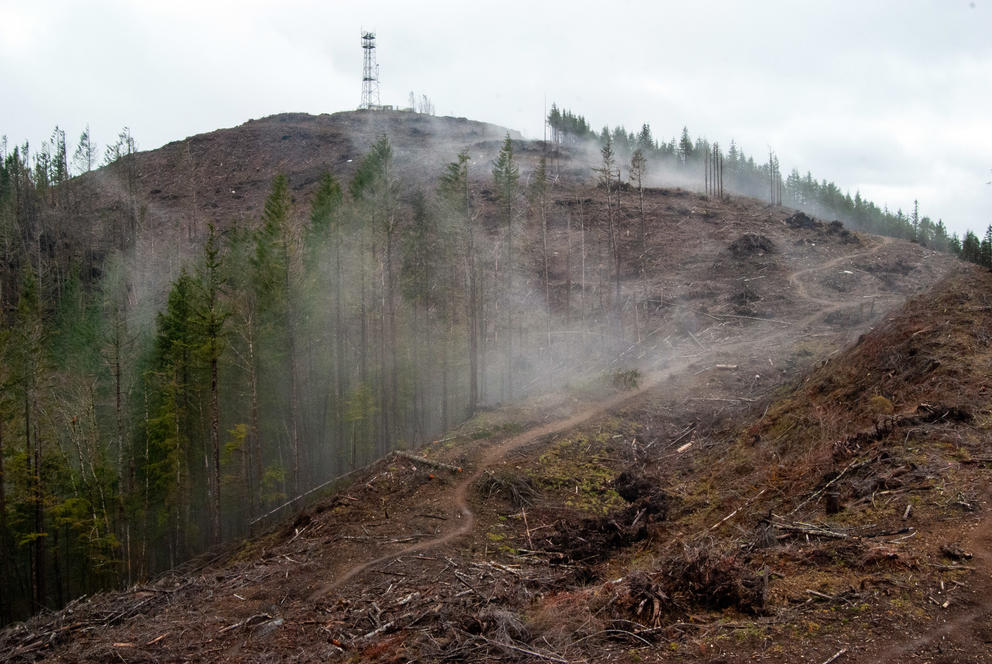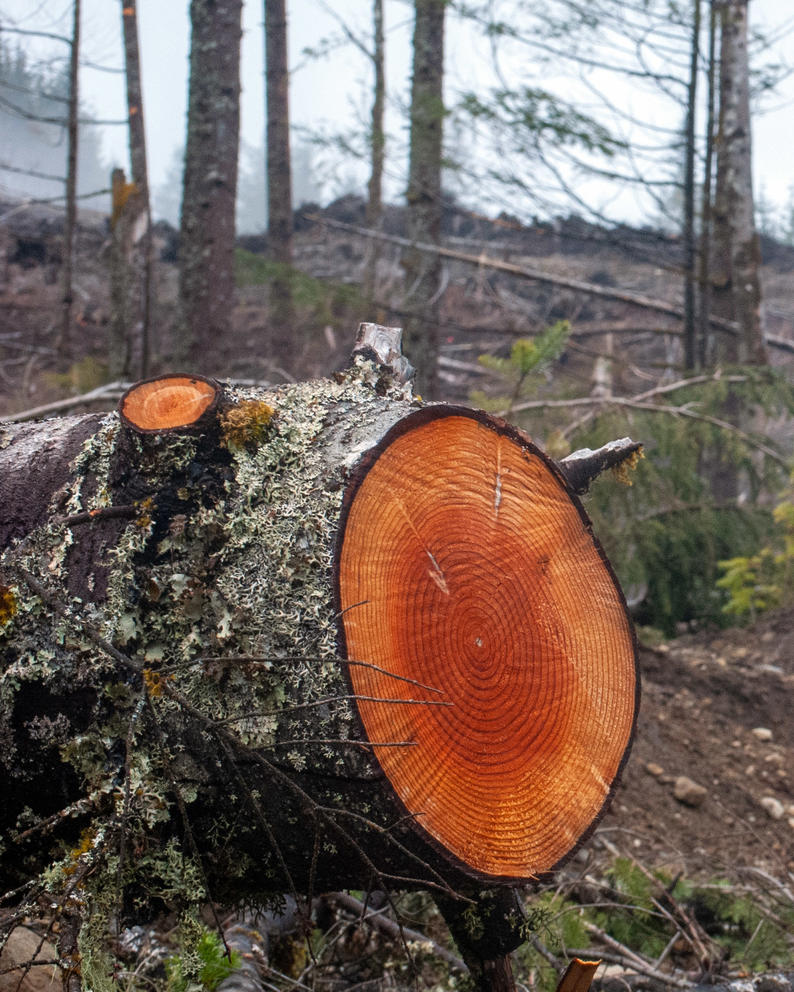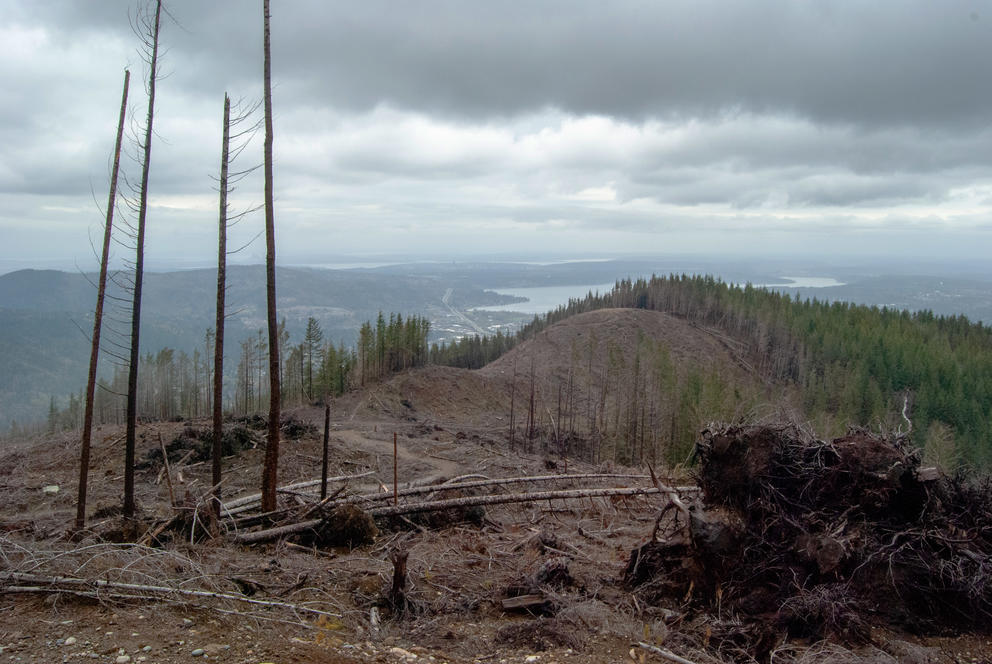That walk through the Spokane nation’s forest was in 2019, when the tribe registered 95,390 acres — a swath of land larger than Seattle — of its forestland to help offset greenhouse gases. It’s a nature-based solution that removes pollution from the atmosphere and retains it within the woody tissue of trees.
It’s also an economic solution that keeps money flowing to the land’s owner without requiring them to cut down any trees. This climate fix could be a $190 billion market by the end of this decade.
While the tribal government’s forestry practices preserve much of its forests while generating revenue, the state of Washington is still trying to do the same as it grapples with a legacy of timber harvesting in carbon-dense forests on the western side of the Cascade Range.
Environmentalists are pushing policymakers to figure out how to lease and manage public lands to industries looking to buy carbon credits. But litigation from the timber industry over how forests should be used is stalling a large part of this effort.
The push and pull of Washington policy concerning its state-owned forest lands is illustrated on Tiger Mountain, a popular urban trail system just a 45-minute drive from downtown Seattle.
Weyerhaeuser logged the summits of Tiger Mountain before opening it for permanent public access in 2021. The Washington State Department of Natural Resources, the agency that regulates timber harvests and also manages state lands there, granted the logging permit while requiring the company to replant a mix of Douglas fir and other species. That restoration work is now underway.
The Natural Resources Department and companies like Weyerhaeuser refer to these areas as working forests, because they say the land provides a sustainable supply of trees for wood and paper production: Plant trees, let them grow, harvest them and repeat.
Harvesting on privately owned Washington forestland makes up 70 percent of state-permitted timber harvests. But the department could reimagine what working forests on public lands can be, according to Rachel Baker, forest program director for Washington Conservation Action, who thinks the government should pivot toward developing policies that govern carbon in state forests.
“We often hear the phrase of, ‘These older forests are carbon workhorses,’” Baker said. “They’re worth much more standing and sequestering carbon than they are as timber.”
Washington’s forestry history
The question of exactly what value that forests have in Washington dates back to its inception as a state.
After the U.S. government displaced Indigenous tribes and peoples, they gave their land to Washington state to manage as an asset that would benefit the public. For decades the Washington State Department of Natural Resources has used the Enabling Act of 1889 as a means to maximize revenue from leasing land to various industries to support public services, including timber sales. A Washington Supreme Court decision last summer found that the benefits derived from Washington’s forests are not limited to monetary support, and that other land management strategies such as conservation and climate fixes are within the bounds of the law.
However, the Court also ruled that the department still has the oversight to manage these lands at their discretion, but the department has yet to deviate from the status quo where there is opportunity.
“This whole system isn’t suited for our modern times, neither in the sense of the climate crisis or in the sense of other opportunities,” Baker said. “We shouldn’t stop cold turkey on stopping harvesting on state lands, but changing how we harvest timber and pairing that with ecosystem services like carbon offsets.”
Last year the Washington State Department of Ecology adopted a Californian forestry protocol enabling projects like carbon sequestration and reforestation to qualify as offset credits under its new cap-and-invest program. The department will likely not be able to offer any credits until 2024 due to its extensive application and verification process.
Currently the department is auctioning allowances for corporations emitting large amounts of pollution, including through smokestacks or tailpipes. Such allowances are auctioned quarterly among the state’s largest emitters, such as oil refineries, manufacturers, natural gas companies and energy providers. In its inaugural year the state has netted $857 million so far through this economic model, legislated through the Climate Commitment Act.
Offset credits and business allowances are priced separately, and often credits are cheaper than allowances, as is the case in California’s similar program. This July, the Golden State sold offsets for $27.25 each while allowances went for about $10 higher, $36.56 — prices that could reflect how much a credit could sell for in forests in Washington. It’s why the Natural Resources Department tried to launch a carbon project in state forestlands last year.
In April 2022 the department called the new project a first-in-the-nation approach to offset credits — with a goal of securing carbon reserves on 10,000 acres of public forestland, effectively reallocating trees slated for logging. Hilary Franz, the outgoing Commissioner of Public Lands, signed an order last spring that immediately moved 3,750 acres into protection status. But the agency has since paused the project amid a lawsuit from a timber-industry trade association.
After the announcement, foresters and land managers in the department began to scope potential areas for the project, according to Duane Emmons, the department’s assistant deputy supervisor for state uplands. The department’s policy writers used a checklist under the state Environmental Policy Act to help identify whether the project could have a significant impact on air and water quality.
It’s the same checklist developers and engineers use for buildings and interstates. If adverse effects are identified, then project managers must submit a proposal through the Act’s environmental impact statement process.
“Our feeling is that leasing land doesn’t require [it],” Emmons said. “When we’re doing things like amending our habitat conservation plan or setting our west side sustainable-harvest level, that’s when we typically do a full environmental impact statement.”
However, the American Forest Resource Council — along with Lewis and Skagit counties, which receive money from timber harvests on public lands — believes the department should have gone through the full process, according to a lawsuit they filed in November 2022. They believe the department overlooked impacts like increased wildfire potential. In California, for example, some forests used for carbon storage have burned, with wildfires depleting nearly one-fifth of their reserves in less than a decade.
Additionally, the forest council is concerned about the communities that rely on timber revenue as government income. Some of the biggest timber harvests happen near small towns and cities on the Olympic Peninsula and in southwest Washington. When timber in neighboring forests is sold to producers — who often use it for furniture products or building materials — part of the revenue is allocated to public services, mostly for school construction.
“Clallam County, for example, versus King County, is far more dependent on state trust land revenue, just because they are surrounded by timber. They don’t have the economic diversification that you would find in King County,” said Nick Smith, public affairs director for the American Forest Resource Council.
The Department of Natural Resources generated nearly $187.5 million through timber sales in 2022, with $32 million going to school construction. Their revenue is down by 4 percent compared to 2021.
That makes up less than 1 percent of what schools receive for construction in Washington state, according to Superintendent of Public Instruction Chris Reykdal. Funds from timber harvests, harbored under the Common School Trust, are diminishing and not proportionally distributed to rural communities, according to a letter he sent to Washington school officials last year.
“Timber harvests are not a driving force for school construction,” Reykdal wrote. “Timber harvests have become an almost insignificant share of total school construction, and timber counties are primarily shipping their wood products and the tax revenues derived from those products to the benefit of urban counties.”
Other tradeoffs
Mill jobs could be most at stake in the transition from harvesting to carbon storage, and there’s no clear plan to support these workers and businesses as the demand for natural resources changes.
Measuring the tradeoffs are challenging both ecologically and economically. While forest-based carbon sequestration projects can be priced and put on the market, more study is needed to understand both the science and the economics of this potential sea change.
“People who do research in this realm right now are people with the background in policy or a different side of resource management, but coming from forestry, we’ve taken quite a different perspective,” said Dr. Lilli Kaarakka, an assistant professor in the Department of Natural Resources Management and Environmental Sciences at California Polytechnic University.
“While we know there’s this market that exists for carbon offsets, we’ve come to see fairly fast that we don’t exactly know what it means on the ground in terms of forest-level management.”
For Kaarakka, part of being a forester is managing biomass, a woody form created by trees and plants as they absorb carbon and other matter around them. Her research, published this July, analyzes California’s Compliance Offset Program, which Washington state adopted as part of its cap-and-invest program. It identifies a gap in precise biomass measurements and what businesses are getting credit for as carbon offsets.
Without a clear metric, foresters can’t measure a difference between new sequestration and the carbon that’s already in the tree, meaning that inventory systems may be overinflating or incorrectly capturing carbon sequestration numbers.
“We’re not paying for the carbon in trees, you’re paying for a change in management that results in more carbon being stored than there would be otherwise,” said Melissa Kreye, professor of forest resources management at Penn State.
Kreye examines tradeoffs in forest management when including carbon credits. She recognizes that small towns have relied on timber harvesting for jobs, and that without timber harvesting governments may have to take on the expense of keeping forests from overgrowing. Forests near populated areas need to be maintained through practices that intentionally set low-intensity fires on forest floors or through machinery that thins tree stands. This management helps keep wildfires from burning large and hot and lofting smoke into the sky for hundreds of miles.
Kreye believes that both the positive and negative impacts need to be weighed in climate-smart solutions. A possible fix: delayed tree harvests. This would lengthen the amount of time forests can sequester carbon, while still eventually providing natural resources for wood products.
The Spokane Tribe is seeking the same balance through their forestry practices and timber harvesting. They work with Finite Carbon, a company that manages reporting, annual monitoring and carbon verification for forests across the country.
Finite Carbon also assists with a project in northeast Washington for the Colville Tribe, which has more than 14 million offsets for sequestration issued across 487,417 acres. The Colville Tribe has sold the offsets to BP under California’s cap-and-trade program, a transaction valued at $100 million, according to a carbon inventory report conducted by the Washington Department of Natural Resources in 2020.
This report called for the full review of the barriers to entering carbon-specific incentive programs. These barriers may be explored through a carbon sequestration strategy that the department is required to develop with a small amount of new funding through the Climate Commitment Act: $80 million for carbon sequestration project planning and $1.5 million for an evaluation of offsets in the latest Omnibus Operating Budget.
The imminent sequestration strategy includes an analysis that could show how revenue from leasing land to carbon credits would stack up, but both environmentalists and the timber industry believe comparing the two only from a monetary standpoint could be a false premise.
“It’s all about how state lands are deciding to participate and how they’re managing already,” Kreye said. “It’s possible to participate and not see a real big change in the amount of wood coming off of public lands. The devil’s in the details."
CORRECTION: This story has been updated to correct the amount of money coming to Washington for carbon sequestration from the Climate Commitment Act.






